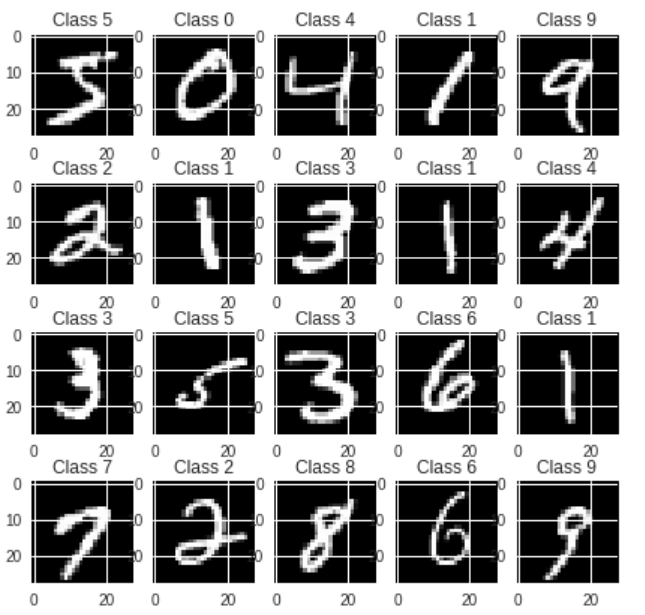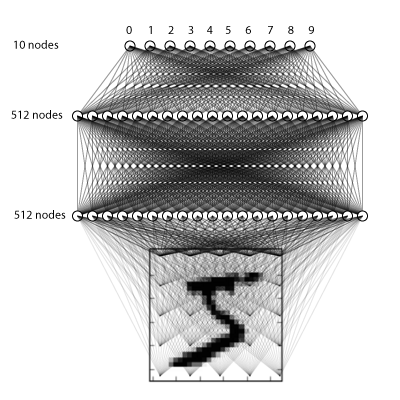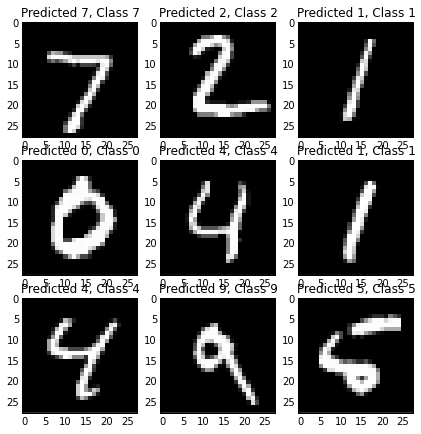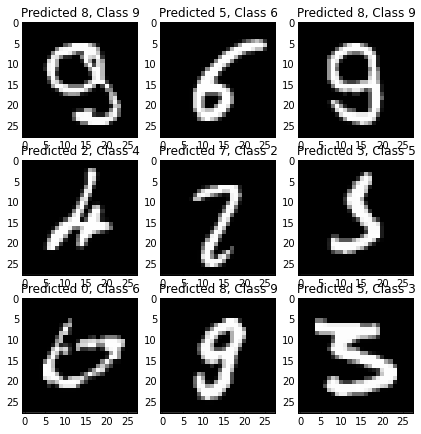MINST手写数字识别(一)—— 全连接网络
这是一个简单快速入门教程——用Keras搭建神经网络实现手写数字识别,它大部分基于Keras的源代码示例 minst_mlp.py.
1、安装依赖库
首先,你需要安装最近版本的Python,再加上一些包Keras,numpy,matplotlib和jupyter.你可以安装这些报在全局,但是我建议安装它们在virtualenv虚拟环境,
这基本上封装了一个完全孤立的Python环境。
安装Python包管理器
sudo easy_install pip
安装virtualenv
pip install virtualenv
使用cd ~进入主目录,并创建一个名为kerasenv的虚拟环境
virtualenv kerasenv
再激活这个虚拟环境
source kerasenv/bin/activate
现在你可以安装前面提到的包到这个环境
pip install numpy jupyter keras matplotlib
2、搭建神经网络
以下代码都在Google Colab中运行
2.1 导入一些依赖
import numpy as np
import matplotlib.pyplot as plt
plt.rcParams['figure.figsize'] = (7,7) # Make the figures a bit bigger from keras.datasets import mnist
from keras.models import Sequential
from keras.layers.core import Dense, Dropout, Activation
from keras.utils import np_utils
2.2 装载训练数据
nb_classes = 10 # the data, shuffled and split between tran and test sets
(X_train, y_train), (X_test, y_test) = mnist.load_data()
print("X_train original shape", X_train.shape)
print("y_train original shape", y_train.shape)
结果:
Downloading data from https://s3.amazonaws.com/img-datasets/mnist.npz
11493376/11490434 [==============================] - 0s 0us/step
X_train original shape (60000, 28, 28)
y_train original shape (60000,)
让我们看看训练集中的一些例子:
for i in range(20):
plt.subplot(4,5,i+1)
plt.imshow(X_train[i], cmap='gray', interpolation='none')
plt.title("Class {}".format(y_train[i]))

2.3 格式化训练数据
对于每一个训练样本我们的神经网络得到单个的数组,所以我们需要将28x28的图片变形成784的向量,我们还将输入从[0,255]缩到[0,1].
X_train = X_train.reshape(60000, 784)
X_test = X_test.reshape(10000, 784)
X_train = X_train.astype('float32')
X_test = X_test.astype('float32')
X_train /= 255
X_test /= 255
print("Training matrix shape", X_train.shape)
print("Testing matrix shape", X_test.shape)
结果:
Training matrix shape (60000, 784)
Testing matrix shape (10000, 784)
将目标矩阵变成one-hot格式
0 -> [1, 0, 0, 0, 0, 0, 0, 0, 0]
1 -> [0, 1, 0, 0, 0, 0, 0, 0, 0]
2 -> [0, 0, 1, 0, 0, 0, 0, 0, 0]
etc.
Y_train = np_utils.to_categorical(y_train, nb_classes)
Y_test = np_utils.to_categorical(y_test, nb_classes)
2.4 搭建神经网络
2.4.1 搭建三层全连接网络
我们将做一个简单的三层全连接网络,如下:

model = Sequential()
model.add(Dense(512, input_shape=(784,)))
model.add(Activation('relu')) # An "activation" is just a non-linear function applied to the output
# of the layer above. Here, with a "rectified linear unit",
# we clamp all values below 0 to 0. model.add(Dropout(0.2)) # Dropout helps protect the model from memorizing or "overfitting" the training data
model.add(Dense(512))
model.add(Activation('relu'))
model.add(Dropout(0.2))
model.add(Dense(10))
model.add(Activation('softmax')) # This special "softmax" activation among other things,
# ensures the output is a valid probaility distribution, that is
# that its values are all non-negative and sum to 1.
结果:
WARNING:tensorflow:From /usr/local/lib/python3.6/dist-packages/tensorflow/python/framework/op_def_library.py:263: colocate_with (from tensorflow.python.framework.ops) is deprecated and will be removed in a future version.
Instructions for updating:
Colocations handled automatically by placer.
WARNING:tensorflow:From /usr/local/lib/python3.6/dist-packages/keras/backend/tensorflow_backend.py:3445: calling dropout (from tensorflow.python.ops.nn_ops) with keep_prob is deprecated and will be removed in a future version.
Instructions for updating:
Please use `rate` instead of `keep_prob`. Rate should be set to `rate = 1 - keep_prob`.
2.4.2 编译模型
Keras是建立在Theano(现在TensorFlow也是),这两个包都允许你定义计算图,然后高效地在CPU或GPU上编译和运行,而没有Python解释器地开销。
当编译一个模型,Keras要求你确定损失函数和优化器,我使用的是分类交叉熵(categorical crossentropy),它是一种非常适合比较两个概率分布的函数。
在这里,我们的预测是十个不同数字的概率分布(例如,80%认为这个图片是3,10%认为是2,5%认为是1等),目标是一个概率分布,正确类别为100%,其他所有类别为0。交叉熵是度量两个概率分布差异程度的方法,详情wiki。
优化器帮助模型快速的学习,同时防止“卡住“和“爆炸”的情况,我们不讨论其太多的细节,但是“adam”是一个经常使用的好的选择。
model.compile(loss='categorical_crossentropy', optimizer='adam')
2.4.3 训练模型!
这是有趣的部分:你可以喂入之前加载好的训练集到模型,它将学习如何分类数字.
model.fit(X_train, Y_train,
batch_size=128, epochs=4,
verbose=1,
validation_data=(X_test, Y_test))
结果:
Train on 60000 samples, validate on 10000 samples
Epoch 1/4
60000/60000 [==============================] - 10s 171us/step - loss: 0.0514 - val_loss: 0.0691
Epoch 2/4
60000/60000 [==============================] - 10s 170us/step - loss: 0.0410 - val_loss: 0.0700
Epoch 3/4
60000/60000 [==============================] - 11s 177us/step - loss: 0.0349 - val_loss: 0.0750
Epoch 4/4
60000/60000 [==============================] - 11s 184us/step - loss: 0.0298 - val_loss: 0.0616
<keras.callbacks.History at 0x7f531f596fd0>
2.4.4 最后,评估其性能
score = model.evaluate(X_test, Y_test,
verbose=0)
print('Test score:', score)
效果:
Test score: 0.061617326979574866
检查输出,检查输出并确保一切看起来都很合理,这总是一个好主意。接下来,我们看一些分类正确的例子和错误的例子.
# The predict_classes function outputs the highest probability class
# according to the trained classifier for each input example.
predicted_classes = model.predict_classes(X_test) # Check which items we got right / wrong
correct_indices = np.nonzero(predicted_classes == y_test)[0]
incorrect_indices = np.nonzero(predicted_classes != y_test)[0]
plt.figure()
for i, correct in enumerate(correct_indices[:9]):
plt.subplot(3,3,i+1)
plt.imshow(X_test[correct].reshape(28,28), cmap='gray', interpolation='none')
plt.title("Predicted {}, Class {}".format(predicted_classes[correct], y_test[correct])) plt.figure()
for i, incorrect in enumerate(incorrect_indices[:9]):
plt.subplot(3,3,i+1)
plt.imshow(X_test[incorrect].reshape(28,28), cmap='gray', interpolation='none')
plt.title("Predicted {}, Class {}".format(predicted_classes[incorrect], y_test[incorrect]))
结果:


总之,这是一个完整的程序,在Keras主页http://keras.io/和githubhttps://github.com/fchollet/keras有其它许多优秀的例子。
MINST手写数字识别(一)—— 全连接网络的更多相关文章
- MINST手写数字识别(三)—— 使用antirectifier替换ReLU激活函数
这是一个来自官网的示例:https://github.com/keras-team/keras/blob/master/examples/antirectifier.py 与之前的MINST手写数字识 ...
- MINST手写数字识别(二)—— 卷积神经网络(CNN)
今天我们的主角是keras,其简洁性和易用性简直出乎David 9我的预期.大家都知道keras是在TensorFlow上又包装了一层,向简洁易用的深度学习又迈出了坚实的一步. 所以,今天就来带大家写 ...
- 深度学习之PyTorch实战(3)——实战手写数字识别
上一节,我们已经学会了基于PyTorch深度学习框架高效,快捷的搭建一个神经网络,并对模型进行训练和对参数进行优化的方法,接下来让我们牛刀小试,基于PyTorch框架使用神经网络来解决一个关于手写数字 ...
- 第三节,TensorFlow 使用CNN实现手写数字识别(卷积函数tf.nn.convd介绍)
上一节,我们已经讲解了使用全连接网络实现手写数字识别,其正确率大概能达到98%,这一节我们使用卷积神经网络来实现手写数字识别, 其准确率可以超过99%,程序主要包括以下几块内容 [1]: 导入数据,即 ...
- 第二节,TensorFlow 使用前馈神经网络实现手写数字识别
一 感知器 感知器学习笔记:https://blog.csdn.net/liyuanbhu/article/details/51622695 感知器(Perceptron)是二分类的线性分类模型,其输 ...
- 【PaddlePaddle系列】手写数字识别
最近百度为了推广自家编写对深度学习框架PaddlePaddle不断推出各种比赛.百度声称PaddlePaddle是一个“易学.易用”的开源深度学习框架,然而网上的资料少之又少.虽然百度很用心地提供 ...
- 深度学习面试题12:LeNet(手写数字识别)
目录 神经网络的卷积.池化.拉伸 LeNet网络结构 LeNet在MNIST数据集上应用 参考资料 LeNet是卷积神经网络的祖师爷LeCun在1998年提出,用于解决手写数字识别的视觉任务.自那时起 ...
- 手写数字识别——基于LeNet-5卷积网络模型
在<手写数字识别——利用Keras高层API快速搭建并优化网络模型>一文中,我们搭建了全连接层网络,准确率达到0.98,但是这种网络的参数量达到了近24万个.本文将搭建LeNet-5网络, ...
- 【百度飞桨】手写数字识别模型部署Paddle Inference
从完成一个简单的『手写数字识别任务』开始,快速了解飞桨框架 API 的使用方法. 模型开发 『手写数字识别』是深度学习里的 Hello World 任务,用于对 0 ~ 9 的十类数字进行分类,即输入 ...
随机推荐
- 浅析Apache/Tomcat/JBOSS/Nginx之区别
浅析Apache/Tomcat/JBOSS/Nginx服务器之区别 一.Apache和Tomcat的区别 Apache是世界使用排名第一的Web服务器软件.它可以运行在几乎所有广泛使用的计算机平台上, ...
- 7.11实习培训日志-Git Linux
Git git子模块 先在GitHub创建两个空的respository,一个super_project和一个sub_project. 然后在git bash中向库中写入一些文件. 在super_pr ...
- std::map的删除
void eraseMap() { int n = sizeof(MmMethod); std::map<CString, int>mapDemo; ; i < ; i++) { C ...
- 51nod1416(dfs)
题目链接:http://www.51nod.com/onlineJudge/questionCode.html#!problemId=1416 题意:中文题诶- 思路:dfs 搜索同一颜色的点.. 只 ...
- 20道Java精选面试必问题(附详细解答),还有什么拿不到的offer
1.什么是Java虚拟机?为什么Java被称作是“平台无关的编程语言”? Java虚拟机是一个可以执行Java字节码的虚拟机进程.Java源文件被编译成能被Java虚拟机执行的字节码文件. Java被 ...
- JS实现购物车动态功能
整理了一下当时学js写的一些案例,觉得购物车功能在一般网站比较常见且基础,现在把它整理出来,需要的小伙伴可以参考一下. 该案例购物车主要功能如下: 1. 商品单选.全选.反选功能 2. 商品添加.删除 ...
- perl C/C++ 扩展(三)
第三讲扩展库使用c++实现,在调用函数后,返回对象变量,perl 能正确使用所有对象成员 使用h2xs 命令生成初始文件 h2xs -A -n three_test 登录目录 cd three_tes ...
- rn-splash-screen 启动页 ios
1.删除iOS工程文件夹下的 LaunchScreen.xib 文件 2. 3. 如果第4步不一样的样式,可以重新走这个图片的步骤就行 4.进入iOS工程的AppDelegate.m中做如下修改: ...
- Java反编译工具JD-GUI以及Eclipse的反编译插件
什么是反编译 高级语言源程序经过编译变成可执行文件,反编译就是逆过程.但是通常不能把可执行文件变成高级语言源代码,只能转换成汇编程序. 反编译是一个复杂的过程,所以越是高级语言,就越难于反编译,但目前 ...
- SpringBoot | 遇坑总结 | JPA
1. Caused by: org.hibernate.HibernateException: Access to DialectResolutionInfo cannot be null when ...
